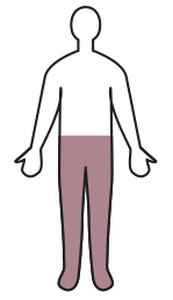

MedFriendly®


Diplegia
Diplegia is paralysis (loss of muscle function) of the same or similar
body parts on both sides of the body. Examples of diplegia would be
when both hands are paralyzed or when two similar parts of the face
on both sides of the body are paralyzed. The face, arms, or legs are
commonly affected in diplegia. In the picture to the right, the purple
area reflects paralysis in both legs.
In children, a common cause of diplegia is cerebral palsy. Cerebral
palsy is a type of brain damage that occurs during pregnancy, during
birth, during infancy, or during early childhood that causes the child to
have difficulties with movement and posture. Most people with
cerebral palsy have diplegia in the legs but the arms are sometimes
affected as well.
FEATURED BOOK: Spinal Cord Injury: Functional Rehabilitatiion
Other types of brain injury (such as strokes) can result in diplegia. A stroke is a burst
artery (a type of blood vessel that carries blood away from the heart) or a blockage of an
artery in the brain.
Infectious diseases, toxic exposures, and metabolism disturbances affecting the brain or
spinal cord can also cause diplegia.
Metabolism is the chemical actions in cells that release energy from nutrients or use
energy to create other substances.
"Where Medical Information is Easy to Understand"™
Treatment of diplegia can involve physical therapy (e.g., strength
training), electrical stimulation of muscles, use of assistive devices
(e.g., walkers, wheelchairs, braces), medication, and surgery. A
common medication used for treatment of diplegia is botox
(Botulinum toxin) because it helps to decrease muscle contractions.
Surgical approaches commonly involve lengthening of the
hamstrings, which improves flexion and motion. Hamstrings are a
group of muscles at the back of the thigh that bend the knee and
swing the leg backwards from the thigh. If the cause of diplegia is
reversible (e.g, infection) then treatment of the cause (e.g., with
antibiotic medication) may reverse the condition.
Diplegia is also known as double hemiplegia. Diplegia comes from the Greek word, "di" meaning "two," and
the word "plege," meaning "stroke." Put the two words together and you have "two stroke," referring to the
two sides of the body affected by the paralysis. Because strokes sometimes lead to loss of movement
and/or sensation in parts of the body, the word "plegia" is used to refer to such conditions. Other types of
"plegias" include quadriplegia, hemiplegia, and paraplegia.















